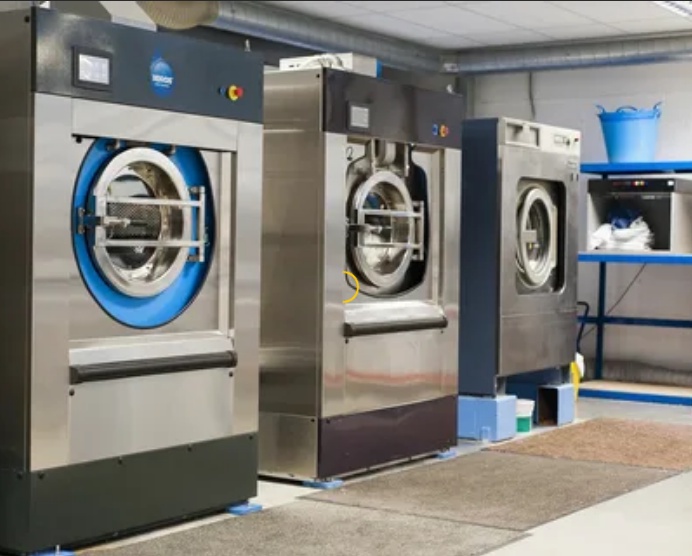Dry cleaning is a modern and specialized garment-cleaning process that doesn't involve water. Unlike traditional washing methods, dry cleaning relies on a solvent-based approach to remove stains and dirt from fabrics. This method is particularly effective for delicate or sensitive materials that may be damaged by water. The process begins with the inspection of garments for stains, followed by pre-treatment using a gentle solvent. The clothes are then immersed in a machine filled with this solvent, which helps dissolve and remove dirt without affecting the fabric's integrity. After cleaning, the garments undergo a drying process to evaporate any remaining solvent. Dry cleaning is a crucial technology for maintaining the quality of various clothing items, ensuring they remain fresh and vibrant without the use of water.

The Pre-Treatment Process
A crucial first step involves meticulous inspection and pre-treatment of stains. A gentle solvent is applied, dissolving and loosening unwanted substances, setting the stage for effective cleaning.
The Dry Cleaning Machine
Garments then enter a specialized machine filled with the chosen solvent. Unlike traditional washing machines, this apparatus doesn't use water. The solvent circulates, dissolving dirt and stains while safeguarding the fabric's integrity.
Preserving Fabric Quality
Dry cleaning excels in maintaining the color, shape, and overall quality of garments. Delicate fabrics, prone to damage with water, benefit from this gentle process, ensuring longevity and vibrancy.
Controlled Drying Process
Post-cleaning, a controlled drying method is employed. This not only efficiently evaporates any remaining solvent but also prevents wrinkles, leaving clothes fresh, clean, and ready to wear.
Stain Removal Expertise:
A standout feature of dry cleaning is its effectiveness in tackling stubborn stains. The solvent's adeptness at breaking down various types of stains, from oil to ink, makes it an ideal choice for intricate patterns or embellished garments.
Dry cleaning aligns with environmental consciousness. The recyclable solvents used minimize environmental impact, and the absence of water reduces energy consumption associated with traditional laundry.
What is the mechanism of dry cleaning?
The dry cleaning process commences with a meticulous examination of each garment to identify and assess any stains or blemishes. This initial step is crucial in determining the appropriate treatment for each item. Once identified, stains undergo a pre-treatment phase where a gentle solvent is applied to dissolve and loosen the unwanted substances.
After the pre-treatment, the garments are placed in a specialized machine designed for the dry cleaning process. This machine, often resembling a washing machine but without the water, is filled with the chosen solvent. The solvent is then circulated through the garments, effectively dissolving and carrying away the dirt and stains. This solvent-based approach is gentler on fabrics compared to traditional water-based washing, preventing potential damage or shrinkage.
Choosing the Right Fabrics
It's essential to note that not all fabrics are suitable for dry cleaning. Care labels indicating compatibility with dry cleaning solvents ensure the process is applied appropriately, maximizing benefits without compromising clothing integrity.
Dry Cleaning Machine: How Can Eco-Friendly?
This technology marks a departure from conventional methods, offering a new, environmentally conscious way of keeping our clothes fresh and clean.

A Shift in the Cleaning Paradigm
Tide's Eco-Friendly laundry and Dry Cleaning brings about a refreshing change in how we clean our garments. Unlike traditional methods that heavily rely on water, this machine utilizes a specially designed solvent. This gentle alternative effectively removes stains, ensuring a thorough cleaning without subjecting fabrics to the potential damage associated with water-based approaches.
Preserving Fabric Integrity
One standout feature of Tide's machine is its commitment to preserving the integrity of fabrics. Delicate materials
You.
Embracing Eco-Friendly Practices: A Closer Look at Sustainability in Everyday Choices
In today's world, the phrase "Eco-Friendly" has become a cornerstone in conversations about responsible living. It's more than just a buzzword; it's a mindset that influences our choices, and one area where this is increasingly evident is in our daily cleaning routines.
The Essence of Eco-Friendly
When we talk about "Eco-Friendly," we're delving into practices that prioritize the health of our planet. It's about making choices that have a minimal impact on the environment, promoting sustainability for future generations.
Understanding Sustainable Cleaning
In the realm of cleanliness, the concept of Eco-Friendly extends to our cleaning products and methods. It involves opting for solutions that are gentle on the environment and avoiding harsh chemicals and processes that may contribute to pollution or harm ecosystems.
Eco-Friendly Approach
Tide, a household name in cleaning, has taken a noteworthy step towards sustainability with its Eco-Friendly initiative. This goes beyond just a marketing tag; it reflects a genuine commitment to reducing the ecological footprint associated with garment care.
Mindful Material Choices
Eco-friendly practices often involve being mindful of the materials we use. In the context of cleaning, this means selecting products and machines that are designed with sustainability in mind, ensuring they align with broader efforts to reduce waste and conserve resources.
Reducing Environmental Impact:
The heart of the matter lies in minimizing our impact on the environment. Tide's Eco-Friendly approach takes strides in this direction, presenting a cleaner, gentler way to care for our clothes without compromising the health of our planet.
Accessible Sustainability
One notable aspect of Tide's Eco-Friendly efforts is its accessibility. It's not a distant, unattainable goal; it's a choice available to everyday consumers. This democratization of sustainable practices makes it easier for individuals to contribute to a healthier planet through their daily actions.
The Ripple Effect
Choosing Eco-Friendly options in our cleaning routines creates a ripple effect. It sends a message that sustainability is not just a trend but a conscious choice embedded in our lifestyle. As more individuals embrace these practices, the collective impact becomes a force for positive change.
What are the eco-friendly dry cleaning methods?
In the realm of organic dry cleaning, two methods stand out as the healthiest choices: Liquid CO2 and wet cleaning by experienced professionals. It's ironic that the healthiest approaches bear the names "LIQUID" and "WET," but their efficacy is undeniable. Liquid CO2 dry cleaning is particularly ingenious, harnessing the power of carbon dioxide in its liquid state to effectively remove stains and dirt from fabrics.
This method is both environmentally friendly and gentle on garments, ensuring a thorough cleaning without the use of harsh chemicals. On the other hand, wet cleaning, when performed by skilled professionals, employs water-based solutions tailored to specific fabrics. These methods not only prioritize the health of the environment but also ensure the longevity and vibrancy of clothing, making them the optimal choices for those seeking organic and health-conscious dry cleaning options.
Conclusion
In conclusion, the technology of dry cleaning represents a sophisticated and specialized approach to garment care. Departing from traditional washing methods, dry cleaning utilizes solvent-based processes to effectively remove stains and dirt without the use of water.
This method, exemplified by its gentle treatment of delicate fabrics, ensures the preservation of garment quality, including color, shape, and overall integrity. The careful inspection and pre-treatment of stains, followed by immersion in a specialized machine and controlled drying, make dry cleaning a versatile and efficient solution.
Additionally, the environmental considerations, such as the recyclable solvents and reduced energy consumption, further highlight the evolution of dry cleaning technology towards more sustainable practices. As a pivotal element in modern garment care, dry cleaning's ability to combine effectiveness with fabric preservation marks it as an indispensable technology for maintaining the cleanliness and longevity of various clothing items.


No comments yet